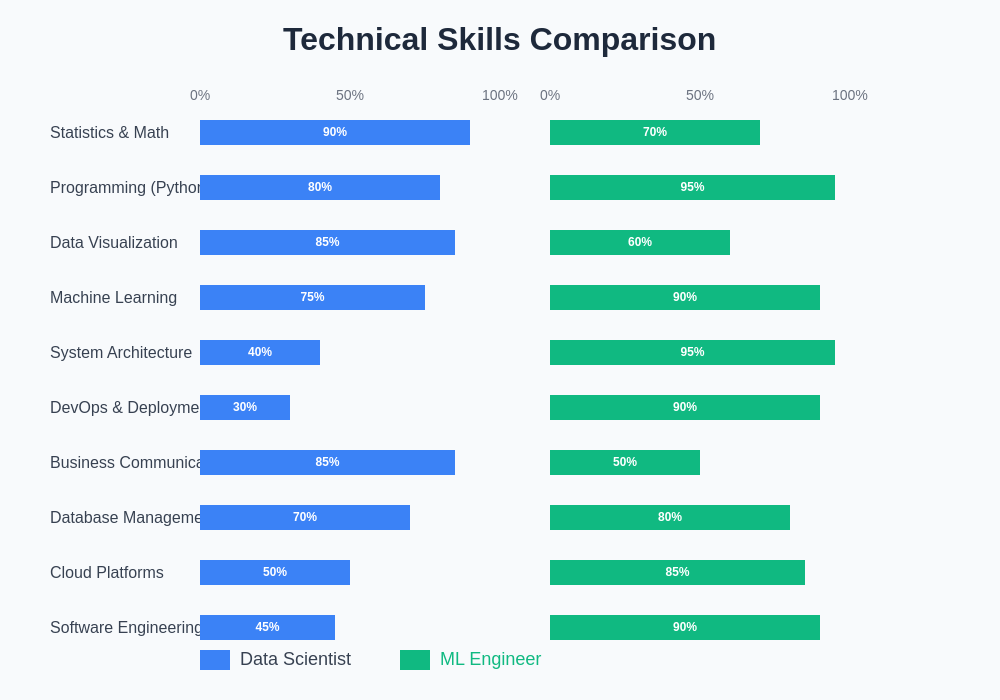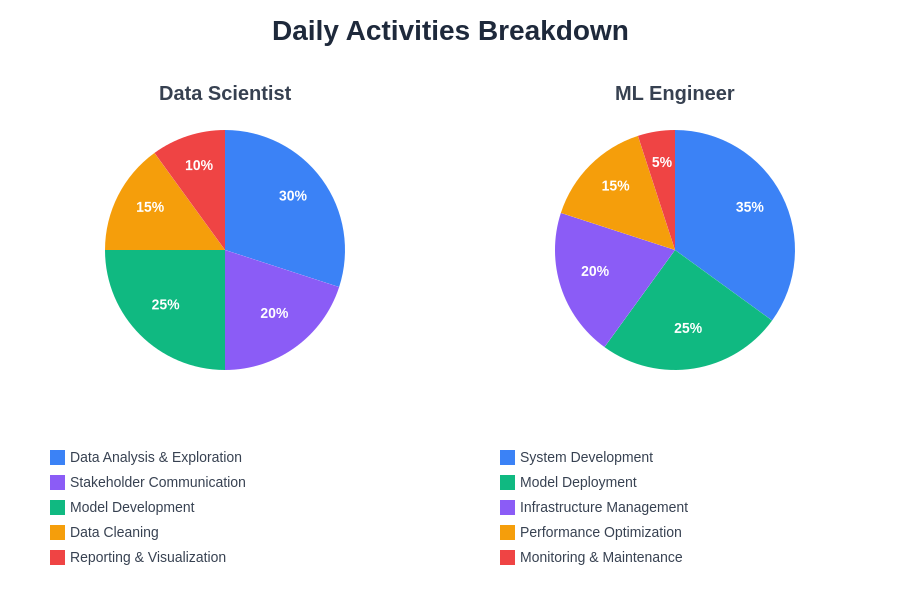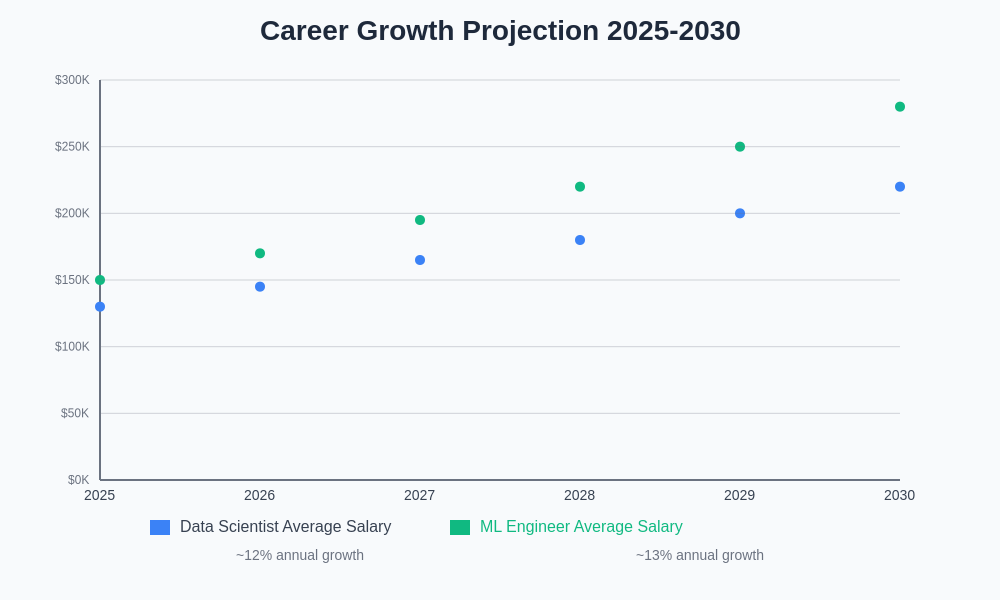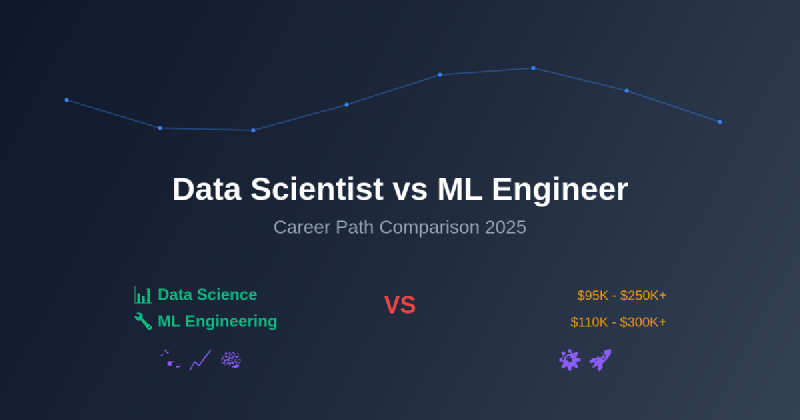The landscape of data-driven careers has evolved dramatically over the past decade, creating distinct yet complementary roles that form the backbone of modern artificial intelligence and analytics initiatives. As organizations increasingly recognize the transformative power of data and machine learning, the demand for specialized professionals has created two prominent career paths that often generate confusion among aspiring technologists: Data Scientists and Machine Learning Engineers. These roles, while sharing common foundational knowledge, have diverged into specialized disciplines with unique responsibilities, skill requirements, and career trajectories.
Stay updated with the latest AI and data science trends to understand how these rapidly evolving fields are shaping career opportunities and industry demands. The distinction between these roles has become increasingly important as companies mature in their data science capabilities and seek to optimize their technical teams for maximum impact and efficiency.
Understanding the nuances between Data Scientist and Machine Learning Engineer positions is crucial for anyone considering a career in the data science ecosystem. The choice between these paths can significantly influence your day-to-day responsibilities, required skill development, earning potential, and long-term career growth opportunities. As we approach 2025, both roles continue to evolve in response to technological advancements, changing business needs, and the increasing sophistication of artificial intelligence applications across industries.
Role Definitions and Core Responsibilities
Data Scientists serve as the analytical backbone of data-driven organizations, combining statistical expertise, domain knowledge, and technical skills to extract meaningful insights from complex datasets. Their primary responsibility involves transforming raw data into actionable business intelligence through exploratory data analysis, statistical modeling, and hypothesis testing. Data Scientists spend considerable time understanding business problems, formulating analytical approaches, and communicating findings to stakeholders who may not possess technical expertise. Their work often involves creating proof-of-concept models, conducting A/B tests, and generating reports that inform strategic decision-making processes.
Machine Learning Engineers, conversely, focus on the productionization and scalability of machine learning solutions. While Data Scientists might develop prototype models in research environments, ML Engineers ensure these models can operate reliably at scale in production systems. Their responsibilities encompass building robust ML pipelines, optimizing model performance for production environments, implementing automated training and deployment systems, and maintaining the infrastructure necessary to support machine learning applications. ML Engineers bridge the gap between data science research and practical implementation, ensuring that theoretical models become reliable business solutions.
The fundamental distinction lies in the focus of each role: Data Scientists prioritize discovery and insight generation, while ML Engineers emphasize implementation and operational excellence. Data Scientists typically work with smaller, cleaner datasets to answer specific business questions, whereas ML Engineers handle large-scale data processing challenges and ensure models perform consistently across diverse production scenarios. This difference in focus naturally leads to variations in daily activities, with Data Scientists spending more time on analysis and visualization, while ML Engineers concentrate on coding, system design, and performance optimization.
Explore advanced AI tools like Claude to enhance your data science and machine learning capabilities with sophisticated reasoning and analysis features that complement both career paths.
Educational Requirements and Background
The educational pathways for Data Scientists and ML Engineers share common ground but emphasize different areas of expertise. Data Scientists typically benefit from strong foundations in mathematics, statistics, and domain-specific knowledge relevant to their industry. Advanced degrees in fields such as statistics, economics, psychology, physics, or applied mathematics provide excellent preparation for data science roles. The emphasis on statistical inference, experimental design, and hypothesis testing makes programs with rigorous quantitative components particularly valuable for aspiring Data Scientists.
Machine Learning Engineers generally require more intensive computer science and software engineering backgrounds. While statistical knowledge remains important, ML Engineers must possess deep understanding of software architecture, distributed systems, and production-level coding practices. Computer science degrees with concentrations in machine learning, software engineering, or systems design provide ideal preparation for ML Engineering roles. Additionally, ML Engineers benefit from understanding cloud computing platforms, containerization technologies, and DevOps practices that enable scalable ML systems.
Both roles increasingly value practical experience and demonstrable skills over formal credentials alone. Data Scientists can build compelling portfolios through Kaggle competitions, independent research projects, and contributions to open-source analytics tools. ML Engineers demonstrate their capabilities through deployed applications, contributions to ML infrastructure projects, and experience with production-scale systems. Continuous learning remains essential for both paths, as the rapid evolution of tools, techniques, and best practices requires ongoing skill development throughout these careers.
Technical Skill Requirements
Data Scientists must master a diverse toolkit spanning statistical analysis, data manipulation, and visualization techniques. Proficiency in programming languages such as Python or R is essential, with emphasis on libraries like pandas, scikit-learn, matplotlib, and seaborn for data analysis and visualization. Statistical software like SAS or SPSS may be required in certain industries, while SQL skills are universally important for database interaction. Data Scientists also need familiarity with machine learning algorithms, though typically at a conceptual level that enables appropriate model selection and interpretation rather than implementation from scratch.
Machine Learning Engineers require more extensive programming expertise, with emphasis on production-quality code, software design patterns, and system optimization. Beyond Python proficiency, ML Engineers often work with additional languages like Java, Scala, or Go depending on their organization’s technology stack. They must understand containerization tools like Docker, orchestration platforms like Kubernetes, and cloud services from providers like AWS, Google Cloud, or Azure. ML Engineers also need familiarity with ML framework internals, distributed computing platforms like Spark, and monitoring tools that ensure production model performance.
The technical skill evolution differs between roles, with Data Scientists focusing more on advanced statistical techniques, causal inference methods, and domain-specific analytical approaches. ML Engineers concentrate on engineering best practices, system scalability, and operational excellence. Both roles require understanding of data engineering concepts, but ML Engineers typically need deeper expertise in building and maintaining data pipelines, while Data Scientists focus more on data quality assessment and feature engineering techniques.

The skill requirements continue to evolve as both fields mature, with increasing overlap in certain areas while maintaining distinct specializations that reflect the unique contributions of each role to organizational success.
Career Progression and Growth Opportunities
Data Science career progression typically follows paths that emphasize analytical leadership and strategic impact. Junior Data Scientists begin by executing well-defined analytical projects under supervision, gradually taking ownership of complete analytical workflows and stakeholder communication. Senior Data Scientists lead complex analytical initiatives, mentor junior team members, and contribute to strategic planning processes. Career advancement often leads to roles such as Principal Data Scientist, Analytics Manager, or Chief Data Officer, positions that combine deep analytical expertise with leadership responsibilities and strategic business influence.
Machine Learning Engineering career progression emphasizes technical leadership and system architecture expertise. Entry-level ML Engineers focus on implementing and maintaining existing ML systems, learning production best practices, and contributing to model deployment pipelines. Senior ML Engineers architect complex ML systems, lead technical initiatives, and establish engineering standards for ML development. Career advancement typically leads to roles such as Principal ML Engineer, ML Engineering Manager, or Head of ML Infrastructure, positions that require both deep technical expertise and ability to guide engineering teams toward scalable solutions.
Both career paths offer opportunities for specialization in emerging areas such as MLOps, AI ethics, or industry-specific applications. Data Scientists might specialize in areas like causal inference, behavioral analytics, or regulatory compliance, while ML Engineers might focus on areas like model optimization, distributed systems, or real-time inference systems. The increasing maturity of the field has created opportunities for technical specialists who can become recognized experts in particular domains or methodologies.
Enhance your research capabilities with Perplexity to stay current with rapidly evolving best practices and emerging opportunities in both data science and machine learning engineering fields.
Salary Expectations and Market Demand
Compensation for both Data Scientists and ML Engineers has remained competitive throughout 2024, with some variation based on specialization, experience level, and geographic location. Entry-level Data Scientists typically earn between $95,000 and $130,000 annually, with experienced professionals commanding salaries ranging from $140,000 to $200,000. Senior Data Scientists and those in leadership roles can expect compensation packages exceeding $250,000, particularly in technology companies and financial services organizations.
Machine Learning Engineers generally command slightly higher compensation due to their specialized engineering skills and the scarcity of professionals capable of productionizing ML systems. Entry-level ML Engineers typically earn between $110,000 and $145,000, with experienced professionals earning $160,000 to $220,000 annually. Senior ML Engineers and technical leads often receive compensation packages exceeding $300,000, especially at major technology companies where ML infrastructure is business-critical.
Market demand patterns show interesting trends heading into 2025. While overall demand for Data Scientists has stabilized after years of explosive growth, demand has become more sophisticated, with employers seeking candidates who combine analytical skills with business acumen and communication abilities. ML Engineer demand continues to grow rapidly as more organizations move beyond proof-of-concept models toward production ML systems. The emphasis has shifted from general data science skills toward specialized capabilities that directly contribute to business value creation.
Geographic variations remain significant, with major technology hubs like San Francisco, Seattle, and New York offering the highest compensation levels. However, remote work opportunities have expanded access to high-paying positions, while emerging tech centers in Austin, Denver, and other cities offer competitive compensation with lower cost of living. International opportunities have also expanded, particularly for ML Engineers with expertise in deploying models across global infrastructure systems.
Day-to-Day Work Experience
The daily experience of Data Scientists revolves around exploration, analysis, and communication of insights derived from data. A typical day might begin with reviewing overnight automated reports, identifying anomalies or interesting patterns that warrant further investigation. Data Scientists spend considerable time in exploratory data analysis, using statistical techniques and visualization tools to understand data characteristics and relationships. They regularly attend meetings with business stakeholders to understand requirements, present findings, and iterate on analytical approaches based on feedback.
Data Scientists also dedicate significant time to data cleaning and preparation activities, as real-world data rarely arrives in analysis-ready format. This involves handling missing values, addressing data quality issues, and creating derived features that enhance analytical models. Documentation and communication represent crucial components of the Data Scientist’s day, as they must translate technical findings into business-relevant insights that non-technical stakeholders can understand and act upon.
Machine Learning Engineers experience more structured, engineering-focused daily routines centered around building and maintaining production systems. Their days often begin with monitoring dashboards that track model performance, data pipeline health, and system reliability metrics. ML Engineers spend considerable time writing and reviewing code, implementing new features for ML systems, and optimizing existing implementations for better performance or cost efficiency.
Collaboration patterns differ significantly between roles, with Data Scientists engaging more frequently with business stakeholders, product managers, and domain experts, while ML Engineers work more closely with software engineering teams, DevOps specialists, and platform engineers. ML Engineers also spend time on system design activities, capacity planning, and technical documentation that enables other team members to understand and maintain complex ML infrastructure.

The work environment and scheduling flexibility also vary, with Data Scientists often enjoying more flexible schedules that accommodate deep analytical work, while ML Engineers may need to respond to production issues and maintain more consistent availability for system support activities.
Industry Applications and Specializations
Data Science applications span virtually every industry, with particularly strong demand in sectors that generate large volumes of customer or operational data. In healthcare, Data Scientists analyze clinical trial results, develop predictive models for patient outcomes, and identify patterns in electronic health records that inform treatment protocols. Financial services organizations employ Data Scientists to develop risk models, detect fraudulent transactions, and optimize trading strategies through quantitative analysis.
Technology companies leverage Data Scientists to improve product recommendations, optimize user experience through A/B testing, and develop insights that drive product development decisions. Retail organizations use Data Scientists to optimize pricing strategies, forecast demand, and personalize marketing campaigns. Each industry presents unique analytical challenges that require domain expertise alongside technical skills, creating opportunities for specialization that can significantly enhance career prospects.
Machine Learning Engineering applications focus more on implementing scalable systems that deliver ML capabilities reliably at production scale. In autonomous vehicle development, ML Engineers build systems that process sensor data in real-time to enable safe navigation decisions. Social media platforms employ ML Engineers to implement recommendation algorithms that can handle billions of user interactions while maintaining acceptable response times.
E-commerce companies rely on ML Engineers to implement personalization systems, fraud detection algorithms, and supply chain optimization models that operate continuously across global operations. Financial technology companies need ML Engineers to implement automated trading systems, real-time risk assessment tools, and regulatory compliance monitoring systems that meet strict performance and reliability requirements.
The convergence of industry expertise with technical skills creates numerous opportunities for specialization. Healthcare ML Engineers might focus on medical imaging systems or clinical decision support tools, while Data Scientists in the same field might specialize in epidemiological analysis or clinical trial design. This specialization often leads to higher compensation and more interesting work opportunities as professionals become recognized experts in particular application domains.
Tools and Technology Ecosystems
The technology landscape for Data Scientists centers around interactive development environments and analytical tools that facilitate exploration and insight generation. Jupyter notebooks remain the standard for exploratory analysis, providing the flexibility to combine code, visualizations, and narrative explanations in a single document. Python dominates the Data Science ecosystem, with libraries like pandas for data manipulation, scikit-learn for machine learning, and matplotlib/seaborn for visualization forming the core toolkit.
R continues to maintain strong adoption in statistical analysis and academic research contexts, particularly for advanced statistical modeling and specialized analytical techniques. SQL remains universally important for database interaction, while tools like Tableau, PowerBI, or Looker are commonly used for business intelligence and dashboard creation. Cloud-based platforms like Google Colab, AWS SageMaker, or Azure ML Studio provide scalable compute resources for computationally intensive analyses.
Machine Learning Engineers work with more infrastructure-focused tools designed for production deployment and system reliability. Docker containers and Kubernetes orchestration are standard for deploying ML models in scalable, maintainable ways. ML Engineers commonly work with MLflow, Kubeflow, or similar platforms for managing the complete ML lifecycle from experimentation through production deployment.
Version control systems like Git are crucial for ML Engineers, who must manage complex codebases and coordinate with multiple team members. Cloud platforms provide essential services for ML Engineers, including managed databases, compute clusters, and specialized ML services like AWS Lambda for serverless model inference or Google Cloud AI Platform for managed model training and deployment.
The technology ecosystem continues to evolve rapidly, with new tools and platforms emerging regularly. Both roles require continuous learning to stay current with technological developments, but ML Engineers typically need to adopt new tools more quickly due to their focus on production systems where reliability and performance are critical.
Remote Work and Collaboration Patterns
Remote work opportunities have expanded significantly for both Data Scientists and ML Engineers, though with different considerations and constraints. Data Scientists often find remote work highly compatible with their responsibilities, as analytical work can be performed effectively with appropriate computing resources and communication tools. The exploratory nature of much data science work allows for flexible scheduling and independent work patterns that align well with distributed team structures.
Collaboration for remote Data Scientists relies heavily on shared notebooks, version-controlled analysis repositories, and regular video conferences for stakeholder presentations and team coordination. Data Scientists benefit from collaborative platforms that enable easy sharing of visualizations, analytical results, and insights with both technical and non-technical team members. The asynchronous nature of much analytical work makes time zone differences manageable for many data science roles.
Machine Learning Engineers face more complex considerations for remote work due to their responsibilities for production systems that may require immediate attention during system outages or performance issues. However, modern DevOps practices and monitoring tools have made remote ML Engineering increasingly feasible. ML Engineers rely on shared development environments, collaborative coding platforms, and robust monitoring and alerting systems that enable effective remote system management.
The collaborative patterns for remote ML Engineers emphasize shared code repositories, automated testing and deployment pipelines, and regular technical discussions about system architecture and performance optimization. Pair programming and code review processes become especially important in remote ML Engineering teams to maintain code quality and knowledge sharing across team members.
Both roles benefit from company cultures that emphasize documentation, clear communication protocols, and regular team building activities that maintain social connections among distributed team members. The success of remote work often depends more on organizational practices and team dynamics than on the specific technical requirements of either role.
Future Outlook and Emerging Trends
The evolution of Data Science and ML Engineering roles reflects broader trends in artificial intelligence adoption and organizational data maturity. Data Scientists are increasingly expected to possess stronger business acumen and communication skills as organizations seek professionals who can bridge analytical capabilities with strategic business impact. The role is evolving toward more consultative responsibilities, with Data Scientists serving as internal advisors who help business leaders understand how data can drive competitive advantages.
Emerging trends in data science include increased emphasis on causal inference techniques, automated machine learning tools that accelerate model development, and specialized applications in areas like responsible AI and algorithmic fairness. Data Scientists are also becoming more involved in product development processes, working closely with product managers and engineers to embed analytical insights directly into product experiences.
Machine Learning Engineering is experiencing rapid growth as organizations recognize the complexity of productionizing ML systems effectively. The emergence of MLOps as a specialized discipline has created new opportunities for ML Engineers who can design and implement comprehensive ML lifecycle management systems. Trends toward edge computing and real-time inference are creating demand for ML Engineers with expertise in optimizing models for resource-constrained environments.
The integration of large language models and generative AI technologies is creating new specialization opportunities within both roles. Data Scientists are exploring applications of these technologies for analytical workflows and insight generation, while ML Engineers focus on implementing these systems reliably at scale. Both roles are adapting to work with increasingly sophisticated AI systems that require new approaches to evaluation, monitoring, and maintenance.

Looking toward 2025 and beyond, both career paths show strong growth potential, with differentiation occurring based on specialization areas and the ability to adapt to rapidly evolving technological landscapes. Success in either role will increasingly depend on combining deep technical expertise with strong collaborative skills and business understanding.
Making the Right Career Choice
Choosing between Data Science and ML Engineering careers requires honest assessment of your interests, strengths, and long-term professional goals. Individuals who thrive on discovery, enjoy working with stakeholders to understand business problems, and find satisfaction in generating insights from data analysis will likely find Data Science more fulfilling. This path suits people who enjoy the variety of working on different analytical challenges and the intellectual satisfaction of uncovering hidden patterns in complex datasets.
Those who prefer building robust systems, enjoy engineering challenges, and find satisfaction in creating scalable solutions that operate reliably over time may gravitate toward ML Engineering. This career path appeals to individuals who like solving complex technical problems, optimizing system performance, and working with cutting-edge technology infrastructure. ML Engineers often find fulfillment in the engineering craftsmanship required to transform research ideas into production-ready systems.
Consider your preferred work environment and collaboration style when making this decision. Data Scientists typically interact with diverse stakeholders and must communicate technical concepts to non-technical audiences, requiring strong presentation and storytelling skills. ML Engineers work more closely with technical teams and focus on detailed technical discussions about system design and implementation challenges.
Long-term career aspirations should also influence your choice. Data Science provides pathways toward strategic business roles and analytical leadership positions that combine technical expertise with business influence. ML Engineering offers opportunities for technical leadership in rapidly growing infrastructure domains and the potential to become an expert in emerging technologies that will shape the future of artificial intelligence applications.
Both careers offer excellent opportunities for growth, competitive compensation, and the chance to work on challenging problems that have meaningful business and societal impact. The choice ultimately depends on aligning your natural interests and strengths with the day-to-day realities and long-term opportunities presented by each career path.
Disclaimer
This article is for informational purposes only and does not constitute career counseling or professional advice. Career decisions should be based on individual circumstances, interests, and goals. The salary information and market trends discussed are based on general industry observations and may not reflect specific situations or geographic locations. Readers should conduct their own research and consider consulting with career counselors or industry professionals when making important career decisions. The technology landscape and job market conditions continue to evolve rapidly, and information presented here may change over time.
